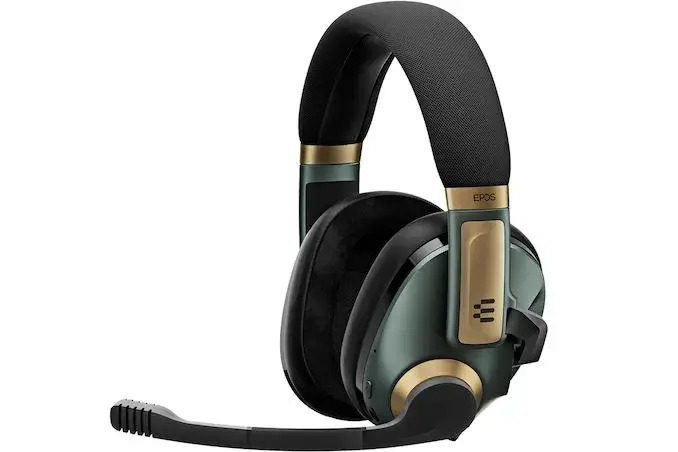- cross-posted to:
- headphones@lemmy.film
- gaming@kbin.social
- cross-posted to:
- headphones@lemmy.film
- gaming@kbin.social
Technically the successor owner of the gaming brand.
Epos has announced that it will be exiting the gaming headphone business and will instead focus on enterprise communications products. The company’s gaming products…

I never understand why we need gaming headphones when normal headphones already do the job well.

It’s mostly marketing and a built in mic. Ever since I got a mic on an arm and good headphones though, that’s all I want to use.

I personally just got a gaming headset for the first time. Before i had a cheap stand mic which due to space i had to place almost behind my screen. It picked up every little sound in the room. Keyboard typing sounds and mouse clicking were hearable a lot. Now with a mic actually on my headphones that issue doesnt exist anymore and people already mentioned that i sound way better. As for mics on an arm, do they need a lot of space?

They just clamp on the edge of your desk and you move them out of the way.

ah ok thanks! maybe will consider that for the future, now i got a headset already which is fine.

Because “gaming” headphones often aren’t “just” headphones. They are headsets with a built-in boom mic
And a boom-mic is often way better than a crap wire mic or bluetooth headphone non boom mic.
There are still the trash ones, but there are also very good ones.
And a built-in mic is extremely useful on multiple situations : console gaming, tight space gaming (no place for a mic), or when there is only a single port on a device (tho a splitter, or hub could be used for a jack port or usb). There is also the convenience of just having a mic.
The issue now with all these headsets being “gaming”, is because of the marketing.
Some headphones brands have put mics on theirs, to make them headsets :
Beyerdynamic with the mx300 : the tight clamp makes it a bit of a no go for me. The mic is as just between ok and great. The voice is full, but there is a lot of noise in there from the reviews I saw.
Audio technica : they have multiple of them. Latest one the ath-m50xsts. It looks like a circum aural headset, but is not. It’s a on ear headset with ear isolation like a circum aural. Which is pretty bad for me. Tho the mic is the best I’ve ever heard on a headset.
They are both wired only.
And other brands not marketing as “gaming” headsets are either extremely expensive with strange mics, or have most of their production budget into audio and they pair the headphone with a trash mic to make it a headset.
In gaming headset brands, there are multiple ones providing software, mic, and wireless features enhancing the experience of the user. For example low latency high bandwidth wireless (proprietary, wifi-like 2.4ghz) connexions only exist in gaming branded headphones/sets. (high bandwidth = higher than bluetooth for the same latency).

I’d take a proper lavalier mic with proper studio headphones over an unwieldy and crappy gaming headset with boom mic any day.
Or better yet, a proper THX reference level capable surround sound system and tactile transducers over any headphones.

Sure with the budget, space, and maybe even enough noise isolation or when you can get open headphones…
But how much would a good enough studio headphone cost? Because from what I understand from studio headphones it’s perfectly calibrated headphones?
Now image your someone without the proper budget to get 1k$ headphones, and no space for open sound. what would you buy?
Maybe beyerdynamic? But for me the clamp force is too high.
Akg? They are cheap, but damn it was impossible for me to wear the akg371 as they were too shallow and had no protection for the driver plastic, and the way they were build made sure I had holes for the sound to get out…
Sadly audio is very subjective, on comfort, space, and sound.

Good studio headphones are around 200€ and you can get decent ones for 100…150€. And generally they are closed back, not open headphones.

Or even just dt-990s + modmic. Still better than any gaming headset ever built.

But that combination costs around 230 Swiss Franks versus 75 Swiss Franks for a Hyperx Cloud Alpha.

Superlux HD 660 Pro / Samson SR850 / AKG K240 + 15€ Lavalier Mic = Better than HyperX Wolkendingsi.

An omnidirectional mic 20 cm downwards from the persons mouth is supposed to sound better than a little boom mic right in front of them? That’s not very convincing.

RGB!!
More seriously, “gaming headphones” are almost always actually “gaming headsets”, ie they have a mic. Good music headphones without a mic don’t fulfil the requirements of quite a lot of gamers, and normal headsets are usually calibrated for voice and not immersiveness in games.

- Step 1: buy good headphones
- Step 2: get a separate mic

Just apply an EQ with more bass and done. Gaming headphones

So they finally realized “Gaming Headphones” are just headphones, great. 👍
Can we have sound cards again, now please?

We do have sound cards in the form of DACs at least

Not having to deal with a sound card driver anymore has been a highlight of my year. Just get a dac and amp

A DAC is just a USB sound card (unless you’re using optical in). But yeah, USB drivers tend to be more reliable since they are generic and usually not written by idiots.

Not really, no. You can use an optical or coaxial output from your mb as well and you don’t need drivers for that.

Only if the DAC includes those inputs, which isn’t the case with all models. Of course, a DAC could also not include a USB input too, but that’s uncommon these days.

I personally love my X-Fi XtremeGamer and i’m not changing it for anything less than a AE-5 Plus.

As someone who just dumped their AE-5 I could not STAND the driver. Windows and Linux. Unless you’re running monitors by default, it’s not worth the hassle. The UI+driver on windows are just clunky, old, and have been the cause of a few BSODs over the years.

Why wouldn’t i have a monitor by default? 🤨
Also, the main reason i have a sound card for is extra performance, and so far the experience has been flawless for me, no BSOD nor similar. 👍

Edit: Turns out that my information is outdated - hardware audio offloading support was added back in Windows 8, apparently!
Original comment: Sound processing hasn’t been offloaded to the sound card since Windows XP - you’ll get no performance improvement from having a sound card.

Benchmarks on my PC say otherwise (and i use Windows 10).

I’m interested in learning more! What benchmarking software are you using and how are you testing that?
Edit: I looked into it and my information was outdated - support for hardware audio offloading was added back in Windows 8! I still have no idea why they removed it between XP and Windows 8, but I’m glad it’s back.

Yeah, when Vista came out it basically killed off sound cards as a mainstream product, both because of the new way the system interacted with the sound card and because of the big increase on CPU (and even GPU) requirements.
But once Windows 8 came out in 2012, x64 finally became standard, and seems sound card manufacturers wanted to give one last hurrah by optimizing their drivers for Windows 8 (which makes them compatible with Win 10 & 11 almost by default).
Now, the sound industry is still pretty much dead to anyone who isn’t an audiophile. But i’m happy to say that they are still products that can enhance your audio, production and gaming experience if you know how to use them. :)

Thanks for sharing, and for putting me right, I appreciate it! I’m very glad that they’ve backtracked on that. While it’s not a huge amount of processing in most situations, I work as a programmer and I don’t love it when I compile code and my music sounds horrible for a few seconds as the CPU gets absolutely massacred by MSBuild.
I have a DAC which is currently connected by USB - it does have SPDIF inputs as well, though. Do you happen to know if they make sound cards with USB output? Or would I need to use the SPDIF output on the card?
I might still have an old sound card kicking around (Creative X-Fi Fatality or something) but I’m not sure it’ll have Windows 8+ compatible drivers, so I might have to get a new one.

Monitors are the name fancy speakers use haha. But yeah, I just switched to a Schitt Modi+Magni for my purpose (HD660Ses)

My x-fi xtremegamers been collecting dust since it got beat out by the schiit modi
Aside from the quality being better I don’t have to deal with that software that doesn’t know wtf a 2.1 setup is.

don’t have to deal with that software that doesn’t know wtf a 2.1 setup is.
Why would software need to know that?

Well, back when sound cards were a thing most people didin’t have a subwoofer (nor do they now being honest).

Not necessarily true. There were multiple PC desktop speakers with subwoofer. My old Altec Lansing kit had one.
Logitech used to make fancy 2, 2.1, and even 4.1 speaker systems.

I’m using a set of klipsch 4.1’s as we speak, and used to drive them with an Audigy 2.

Can we have sound cards again, now please?
I’m happy with my FIIO, works great with my beyerdynamics and no separate driver needed

Epos make a couple of USB DAC/AMPs too, and the GSX 1000 is apparently reasonably well received. Haven’t used one personally but it shows up on my Amazon recommendations occasionally.

It wasn’t even Sennheiser, it was a company Sennheiser had licensed their name to.
It’s really unfortunate that Sennheiser has diluted their brand so much. Between this deal with Epos and their consumer division going to Sonova, it’s hard to tell what’s actually still made by Sennheiser. I imagine it will become more evident as Sonova starts designing new products and they start to diverge.

Literal decades ago I bought Sennheiser headphones. They were great. They later orders of magnitude longer than anything I had before. They fit well, and were foldable, making them very compact when not used. And they were cheap too.
When they finally broke down I naturally wanted Sennheiser again, but they referred me to their new brand Epos. I bought a headset this time, not just headphones. It was a lot more expensive, and I was terribly disappointed by the ergonomics. It’s also rather big, making it unwieldy when not in use. And they broke already, though I was able to fix it - they broke just out of warranty of course.
Of course this is just one anecdote, but it really does feel like another great brand sold out and became crap.

I’m amazed it took this long, honestly. These are like gaming chairs: overpriced configurations with a combination of features that result in lower quality/durability when put together. I switched to a separate desktop mic years ago (paired with a fantastic set of Sennheiser headphones, coincidentally) and haven’t looked back.
I highly recommend a dedicated mic. The low-end options are very affordable and you’ll still sound way better on Discord (or Zoom calls!) than you will on a gaming headset mic or a webcam mic.

There’s plenty of ease of use with headphones though, I got a pair of sennheiser gaming headphones and flipping up to mute is convenient.

yeah tbh I don’t think the comparison to gaming chairs is 100% there. Everyone can benefit from a better office chair, but most people can’t perceive the audio difference between a gaming headset vs dedicated audiophile headphones + dedicated mic. While it may be true that it sounds better, it’s just not worth the extra hassle for most people. I have a wireless Arctis headset and the ease of use is unreal.

Yeah. For a while I thought about upgrading to a desk mic and semi open headphones, but after looking at my desk, yeah, having a mic in front of me would be hella uncomfortable. Not to mention, I’d probably knock it over accidentally and fuck it up within a month.

Have you looked at boom arms? They reach up and over and won’t get in the way of your hands/arms.

Hm, I hadn’t thought of that possibility, honestly. I’ll look into it, thanks!

I had a dedicated standing mic that had to be put almost behind my screen because of space. Due to this everyone always was able to hear my keyboard and mouse sounds. Got a gaming headset from Teufel Zola and people already mentioned i sound way better than before

I disagree, unless it’s the modmic, there are enough people who either don’t have the space nor want to spend the money to properly place the mic (ie as near their face as possible). I’d rather they use some mediocre headset mic then place something that’d be otherwise decent like a Samson Go on a tiny tripod on the table next to their gaming keyboard, 20-30 cm away from their mouth.

My snowball would like a word. If you could hear it. Over it picking up everything else in the room.

If I had a dollar for every time people recommended Blue mics while any dynamic mic would’ve been a better option, I’d be a rich man.

The problem with blue products, isn’t the quality but rather it’s the price, you can get so much more for the same amount of money as a snowball or yeti.
As for it being too sensitive, try turning it down andoving closer to it, or just using a noise gate, or even noise reduction (like rnnoise based or RTX voice). There are plenty of options for tuning a microphone for better quality. And you don’t have to go for the manufacturers software.
Personally I have a Audio interface with an XLR AT2020, and my noise gate and compressor plugin chain running on Carla works fine for what I have on my Linux setup, but you don’t even have to go that far. All you need is something like voicemod, voicemeeter, EasyEffects or noisetorch or other standalone setups.

I’m just using pulse effects for gates and compressors.
I was more talking about it’s not a directional mic and sound from behind it is no different to the mic as sound in front of it really. So it just picks everything up.

Ahh, a noise reduction setup like rnnoise (noisetorch) might actually help you with that - you can use it to replace the noisegate, as it has voice activation detection which works like a noisegate

It’s not a big deal really. I do like the mic because I paid next to nothing for it. (Yay, cheap marketplace shit.) Besides, I rarely use it.
That and I’ve had to switch over to flatpak pulse effects which refuses to see the mic and allow me to add effects. (The flatpak version of pulse effects didn’t even fix the problem I had anyways.)

If you are willing to switch to Pipewire, try EasyEffects, it might work better as it’s based off of pulse effects, but for Pipewire, it’s actually developed by the original Devs of pulse effects - in fact the original pulse effects repo is now the easy effects repo, the old pulse effects hasn’t actually been updated for an entire year now, so you might notice it working less and less well.
To me, Pipewire is the best option for audio on Linux at the moment, it combines the power and low latency of JACK with the ease of use, and multiple device capability of PulseAudio, it really is a great project and is pretty much rock solid at this point in time. It might also fix your issues with pulseeffects/EasyEffects not recognising your microphone.
Honestly, I still don’t use flatpaks for specific things - namely OBS, as I have a Blackmagic capture card, and the flatpak version of OBS won’t support it due to how the BMD driver is required to be installed. Sure it’s good for a lot of things, but sometimes the other options are better for your purposes. I still use the AUR Tytan652 version.

There’s a case for low latency wireless headphones, and it’s pretty gaming specific. But yeah, they don’t need the branding or any of that.

Reading reviews of the pictured model, apparently they sounded like crap?
I mean, they’re beautiful, and the magnet attached mic is inspired, but if they sound like garbage what’s the point?

Yeah, some Chinese company bought the Sennheiser gaming headphone brand from Sennheiser, named themselves Epos and crapped out kinda meh products. Nothing worth carrying the Sennheiser name.

Me with my HD598s with a modmic and Bluetooth DAC zip tied to the headband:

Didn’t Sennheiser get sold already

Kind of sad. I got some EPOS mic+phones for pretty cheap, albeit not as good value as just micless Sennies, and I think the space saving is actually really good. I barely have room for my mic, and it gets worse when I’m somewhere with very little desk space to work with. It seems very difficult to get something that combines all the needs of: flat frequency response and an adequate quality mic, very little by way of space requirements, and a not-outrageous price. I just fold the mic up and put it where I have space for my headset, ezpz.
I’m open to suggestions for replacements, of course.

One way would be to use small mics, like a lavalier mic.
Tho they are omnidirectional, and without noise cancellation. They also aren’t as good quality as a big mic.
Another way would be to use something like the modmic from Antlion. They have different models, but all seem worse quality for the sound than the modmic 5 they discontinued.

They’re worse than modmic 5 but still better than any gaming headset mic.

That is not true at all.
Epos “still” has great mics on the h6 pro.
Corsair has very good mics on the premium headset (virtuoso), and the wired hs80.
Razer also has a very good mic on the blackshark v2 pro 2023 (not the old one).
Hyperx has a very good mic on their wired cloud 3.
Drop x Sennheiser has a good mic on the pc38x.
Beyerdynamic has a very good mic on their mx300 gen2
Audio Technica has be best ever mic on a headset currently on the m50xsts (or other with the same mic, not sure if they have other similar ones).
And all of these mic sound better than what modmic has currently not discontinued.

I could recommend you beyerdynamics MMX 300, however the price might be the turning point for you. But getting them in a good B-sale is totally worth it in my opinion.
Edit: You can combine them with an Equalizer Software by downloading the wave file for the MMX 300 and applying it. I forget the name though. Something Something APO? They have a GitHub page if I am not mistaken.

Used to live by Sennheiser headphones
Then I discovered ANC headphones. Then my phone lost its headphone jack.
Until Sennheiser have an ANC BT headphone option to rival Bose or Sony, they have lost that market segment.

I’d rather they bring out some nice open back bluetooth headphones. Much better imaging, which is great both for music and shooters, and more comfortable for a lot of us. I just want the convenience of wireless, I don’t need ANC.
Maybe Audeze will do it with a Maxwell stable mate.

I had a similar issue recently with not being able to plug my phone in to my car headphone jack so I bought a headphone jack to USB c cable. Works pretty well

I’m still waiting for a microphone that’s coming out of a three to four pin mini-xlr adapter: Plug one side into the headphone, the other takes the cable (now with three instead of two leads (plus shielding/ground)), voila, a headset.
Also Sennheiser’s build quality at the lower end it atrocious. Sennheisers priced in the same ballpark as e.g. AKG K240s might be a bit more neutral but you probably don’t have the ears to notice and a) no replaceable cable b) you can’t step on them and they’ll be fine (K240s are what recording studios whip out when a punk band comes in with three crates of beer) and c) they fit like ass and the plastic creaks like a motherfucker.
(Also to be fair to make a K240 nice you’ll have to invest what ~20 bucks into velour pads, and another 20 into a proper cable (the included one is shoddy and will break at the earliest opportunity. 15 for the connectors (“neutrik/rean or bust”), the rest for the actual cable, make it as long as you want impedance doesn’t care. Plus maybe two connectors more to have a predetermined breaking point. Soldering iron not included. Also wash your fucking ear pads)

A lot of haters in this thread but the PC38X (and family of confusing names) has been me, my wife, and my friends go-to head sets for the last five or more years.
Decent price, quality, weight. Light enough to wear for hours without going sore, but sturdy enough not to snap.
The quick mute boom mic is awesome and my original G4ME ONE (Lol naming) came with a cheesy USB sound card with sidetone which is a great feature that I still try to get on dac/Amos today.
I will be pouring one out for my homie tonight.

PC38X is a reasonable headset, but I’m guessing Epos wanted higher margins but couldn’t get them to stay in the business. As much cachet as the Sennheiser brand might have had, the gaming headset space is pretty competitive and there are plenty of decent headsets for not a lot of money.

Not really hating on it. It seems to be pretty good for the quality and price.
However it is presented by reviewers as having a very tight clamp, which is a huge pain me, wearing glasses…
It’s also open back wich obviously (I hope), isn’t adapted to everyone.

Oh, I actually like my gsp 500 too :( it’s lasted me for years, has a nice long cable, and gives decent audio quality after I got a pci-e audio card to boost levels. I’ve always preferred a combo headset over separate headphones and mics because it’s less to juggle, but so many out there are cheap garbage. Guess I’ll have to find a new solution whenever these die on me

Audeze makes the best ones, but $$$

I’ve also seen meze get nice reviews, with it’s new 109 pro, or more expensive ones.
The 99 seem great too from reviews, but very bassy/bass forward.

I have the 99 and have heard the 109pro, the latter isn’t recommended unless you have tube amps. 99s can work off anything and are my goto pairs at work. A bit muddy and focused towards the mid end but at the end of the day miles ahead of cheap cans.

This reviews https://youtu.be/j-xLIQLMWV4?si=bbG1AeMEMCNq61GD says it’s pretty easy to drive them with anything.
Not sure about amps, and they are expensive headphones, so not that interested in more reviews.

Ya i thought so too, but it sounded too thin with transparent sources. You might like it but I prefer a warmer response.
But what I’m sure of is that listening to reviews doesn’t work as I thought.

It works mostly for the technical side.
For the sound, preferences and personal comfort, it’s a bit hard to get precise. The graphs can help a bit, but it’s also hard to understand them, even more when they don’t look the same between reviewers.

